The Trump tax plan—the Tax Cuts and Jobs Act (TCJA)—was passed by a narrow margin in 2017 without a single Democrat vote in the House of Representatives or the Senate. Republicans argued that the TCJA’s tax provisions and rate reductions would help to grow the economy and provide relief to working-class families.
Opponents of the bill argued—as they still do—that the tax bill would mostly benefit “millionaires and billionaires” and increase the federal budget deficit. We still hear top Democrats argue that the reason the deficit exploded in the Biden years was that the tax cuts blew a revenue hole in the budget, thus worsening the national debt.
Some of the tax cuts in the TCJA were permanent, and others have begun to phase out. If no action is taken by the Administration and the Congress, much of the TCJA will expire—although the corporate tax cuts were made permanent.
Democrats favor allowing most of those tax cuts to expire, while Republicans want to make the tax cuts permanent or at least extend them. What is clear is that the “do nothing” option would automatically trigger one of the biggest tax hikes in modern times, so a new tax bill is clearly coming in 2025.
This study examines the actual evidence of what has happened in the seven years the tax cut has been in effect. There are so many factual errors swirling around regarding what is in the TCJA and its impact that it is a wonder that the "truth screeners" on the Internet haven’t flagged the coverage as “disinformation.”
Using government economic and fiscal data shows that the law has:
- Increased the competitiveness of the U.S. economy,
- Benefited middle-class families,
- Vastly simplified the tax code,
- Increased tax payments by “the rich,”
- Virtually eliminated the Alternative Minimum Tax,
- Cut the number of families who are burdened by the unfair death tax by more than half,
- All but eliminated corporate tax inversions and the flight of jobs out of the United States, and
- Generated more revenue for the government than had been predicted if we had kept the old tax system in place.
Major Features of the TCJA
Most of the media and the political class focus on the reduction in the highest personal income tax rate and the cut in the corporate rate, and those were major goals of the bill in terms of growing the economy. But many other features of the bill are underappreciated. Among its major reforms, the TCJA:
- Nearly doubled the standard deduction from $12,500 to $24,000,
- Cut the corporate tax rate from 35 percent to 21 percent,
- Lowered the effective tax rate on repatriated foreign earnings to 10.5 percent,
- Eliminated the marriage penalty from tax brackets below $500,000,
- Eliminated the alternative minimum tax for most households,
- Capped the state and local tax deduction at $10,000,
- Reduced the small business tax rate from 39.6 percent to 29.6 percent.
- Reduced the highest income tax rate from 39.6 percent to 37 percent,
- Allowed immediate expensing for many types of capital purchases and research and development,
- Raised offsetting revenues by allowing drilling for oil in Alaska,
- Repealed the Obamacare mandate requiring Americans to buy health insurance, and
- Reduced tax rates for all tax filers across the income spectrum.
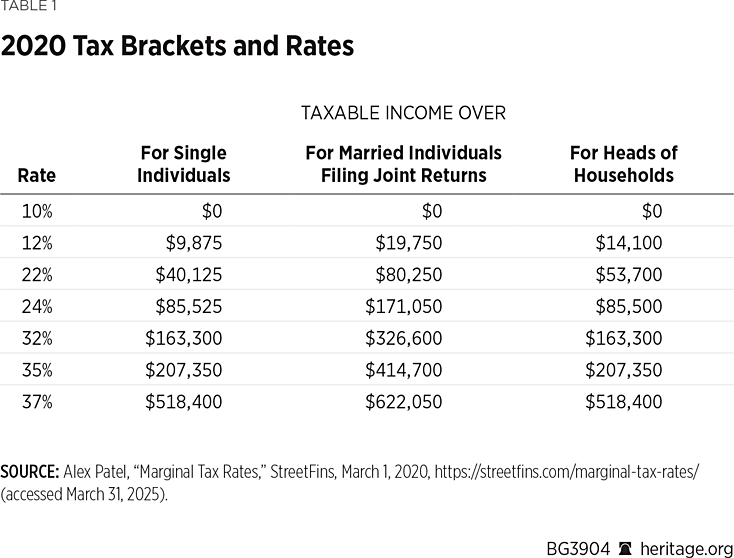
Impact of the TCJA
The Trump tax law was one of the biggest middle-class tax cuts in U.S. history. The Trump Treasury Department calculated that the average family of four saves roughly $2,000 a year from the tax cut.REF This means that allowing the bill to expire would raise taxes for most families making less than $400,000.
The House Budget Committee has estimated that the typical family will pay $1,500 more in taxes annually if the Trump tax cut is allowed to expire.REF This would be one of the largest middle-class tax increases in several decades.
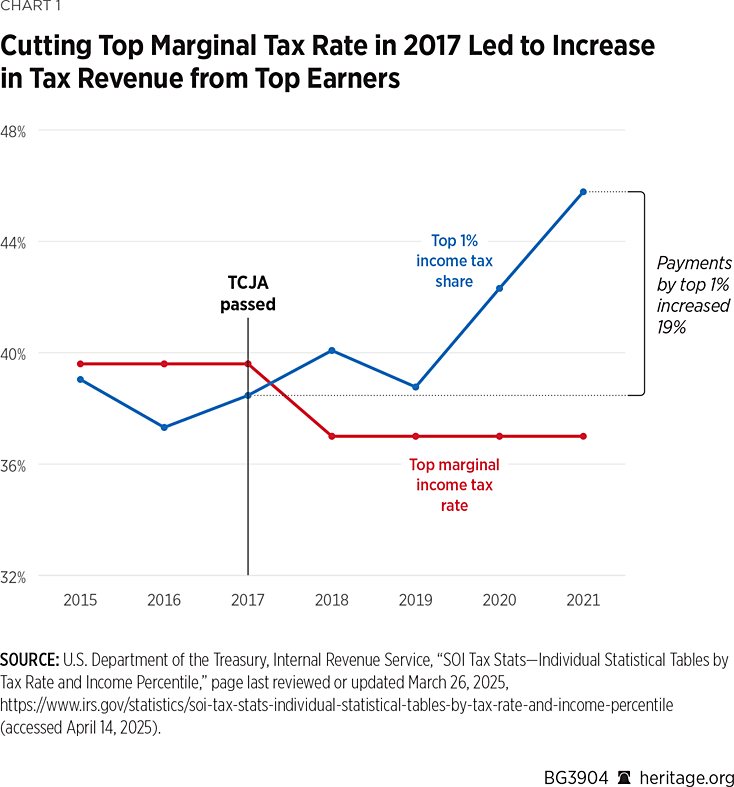
The Trump tax cuts vastly simplified the tax code for the majority of Americans. The purpose of the tax system should be to raise sufficient revenue to fund the essential services of government with the least cost and disruption to the economy. This is why a broad tax base (with few deductions) and lower tax rates result in a more economically efficient tax code.
One of the TCJA’s major provisions nearly doubled the standard deduction from $12,500 to $24,000. As a result, before the Trump tax cuts, about 31 percent of tax filers had to itemize their deductions and keep track of shoe boxes full of receipts and other transactions related to mortgage payments, charitable deductions, interest payments, and so on. Now more than 90 percent of Americans—and almost all middle-income and lower-income families—just check a box for the standard deduction and don’t have to calculate the deductions for which they are and are not eligible.REF
Allowing this provision of the tax bill to expire would be a major policy blunder. Lowering the standard deduction would be a major tax increase on the middle class and would cause a lobbyist feeding frenzy as special interests scramble to poke holes in the tax code with more special-interest deductions. This would also mean millions more hours of tax complexity, which is a dead-weight loss to the economy and a gift to the tax-preparer industry. April 15 would be an even more dreaded day for tens of millions of tax filers.
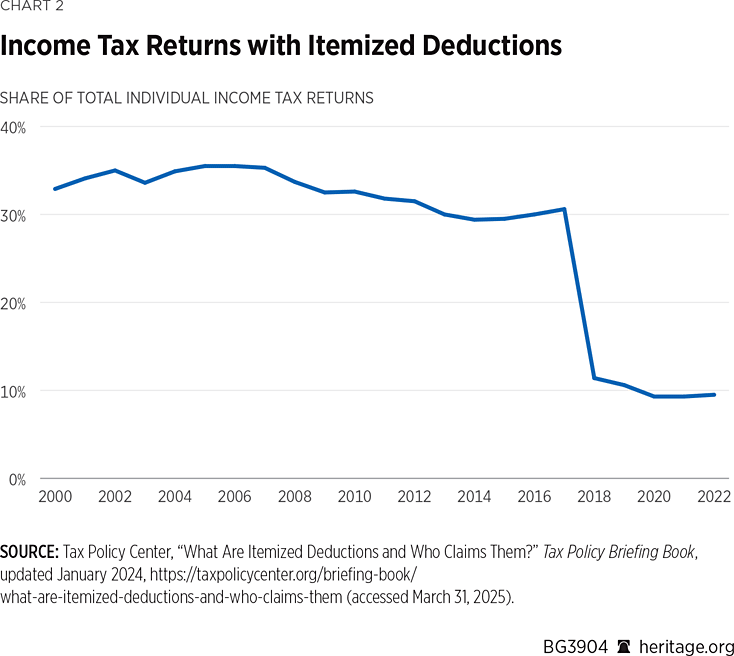
The TCJA made millionaires and billionaires pay their fair share. One of the Trump bill’s most valuable features was to cap the deduction of state and local taxes for the super-rich at $10,000. Before this reform, the richest 1 percent of tax filers in high-tax states (including New York, New Jersey, and California) were able to pay billions of dollars less in federal income taxes than equally wealthy tax filers in low-tax states like Florida and Texas had to pay. This was an unfair loophole and only encouraged states to raise their income taxes because the federal tax laws allowed high-tax states in effect to export their tax burdens to residents of lower-tax states.
The deductibility of state and local taxes also incentivized states and localities to increase the government provision of services like garbage collection over private providers because the government service was subsidized by a federal tax write-off. In other words, the state and local tax (SALT) deduction discouraged more efficient private provision of government services.
A reinstated SALT deduction would be one of the largest tax loopholes for the wealthiest tax filers in the history of the United States and would save blue-state tax filers $1.1 trillion over the next decade with most of the tax cut benefitting those making more than $400,000: The wealthier the tax filer, the larger the tax cut.
Ironically, this policy change is almost entirely and exclusively (with a handful of exceptions) supported by Democrats. Senate majority leader Chuck Schumer of New York has said that reinstating the SALT deduction giveaway is one of his highest priorities.REF Where is Bernie Sanders when we need him?
So much for tax fairness.
The Trump tax cut did not cause the record-high deficits. A study by Heritage Foundation Research Fellow Preston Brashers examined the impact of the Trump tax cuts after four years and found that the U.S. actually raised more corporate tax revenue in the first four years following passage of TCJA than the Congressional Budget Office (CBO) predicted would be raised without the tax cut.REF The House Budget Committee similarly concluded in a May 2024 analysis that “[t]he Trump tax cuts resulted in economic growth that was a full percentage point above CBO’s forecast.”REF Federal revenues were $200 billion a year higher in 2024 than was predicted by the CBO before the tax cuts.
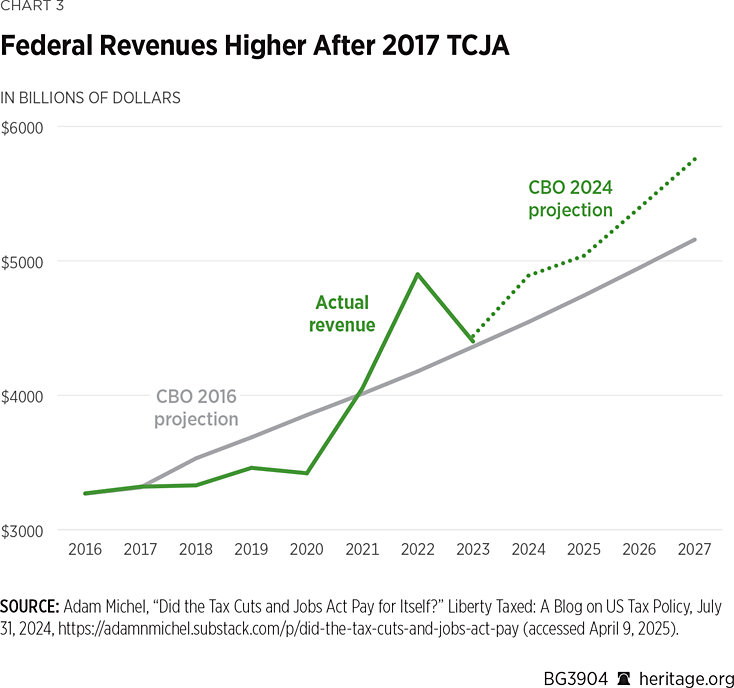
In other words, cutting taxes did not punch a revenue hole in the budget. The meteoric rise in the deficit and the $8 trillion addition to the debt since 2021 have been entirely attributable to overspending.
The rich paid more, not less, in taxes after the Trump tax cut. President Joe Biden and congressional Democrats claim that the major reason the deficit has exploded is that Trump cut taxes on the rich. Wrong: Five years after the Trump tax cuts, the IRS’s own data show that the top 1 percent of earners in America saw their percentage of total income taxes collected rise from 40 percent to 46 percent of the total in 2022.REF This was the largest share of taxes ever paid by the rich.
With or without the tax cut, the U.S. has a highly progressive tax system. Average tax rates as a share of income rise steadily across the income spectrum.
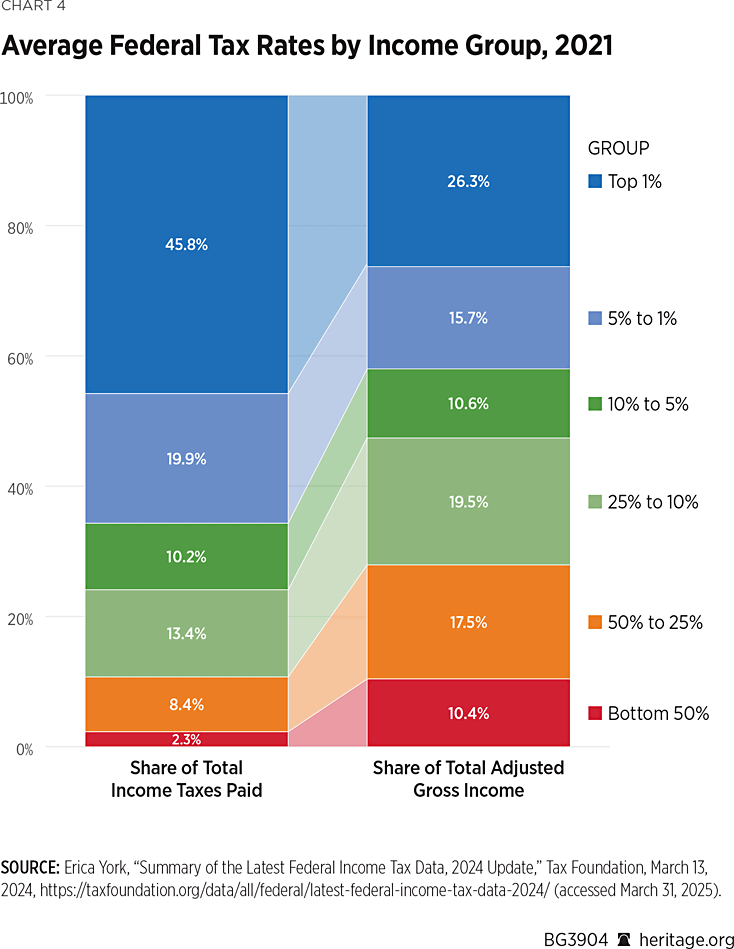
The alternative minimum tax was all but eliminated. Donald Trump all but eliminated the administratively burdensome alternative minimum tax (AMT). Before the Trump tax cut, about five million Americans were ensnared by this tax. Many millions more had to fill out the AMT forms to see whether they were subject to the penalty. Under Trump, the number of AMT filers fell to 200,000 according to the Tax Policy Center.REF Most of this relief went to American families making $80,000 to $300,000.
This virtual elimination of the AMT was one of the unsung achievements of the Trump tax cut. The AMT was invented back in 1969 and targeted a small number of super-rich Americans who had found clever ways to avoid paying any income tax. But instead of ensnaring just millionaires and billionaires, it mostly hit people who were not rich.
The Democrats want to repeal the Trump tax cut and bring back the AMT. Under their plan, more than seven million Americans will pay the tax starting in 2026, and the number will rise steadily to 10 million filers by 2034.REF
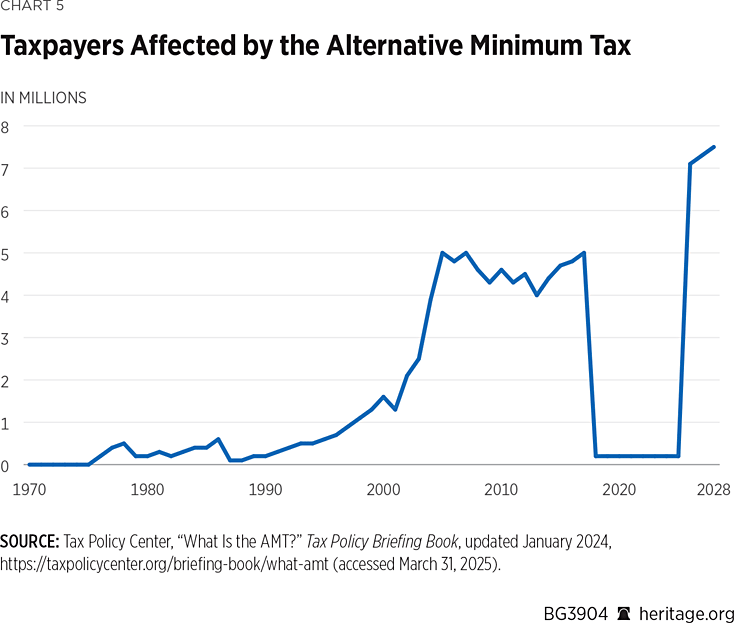
The death tax was eliminated for thousands of non-rich households. The Trump tax cut doubled the exemption amount for paying the estate tax from roughly $5 million to $10 million. With inflation adjustments, the exemption stands at $13.99 million today. The American Business Defense Foundation reports that the higher estate tax exemption reduced the number of family estates subject to this tax by more than half.REF But according to the IRS, “Under the tax reform law, the increase is only temporary. Thus, in 2026, the exemption is due to revert to its pre-2018 level of $5 million, as adjusted for inflation.”REF
Democrats want to use the estate tax as a way to soak the millionaires and billionaires, but under their plan, thousands more families will be subject to this tax when a parent dies. They are mostly owners and operators of small businesses that have been built up over a lifetime to million-dollar-plus enterprises. The owners have already paid Uncle Sam millions of dollars of income, property, payroll, energy, business, and other taxes and annual levies.
If the TCJA expires, thousands more estates each year will pay a 40 percent tax in addition to another 5 percent to 15 percent depending on the state where the estate is located. Roughly half of a family inheritance must be forked over to the politicians. The IRS gets almost as much as the children and grandchildren.
The U.S. already has one of the most onerous and confiscatory death taxes in the world. Subjecting more Americans to this tax would be both unfair and harmful to the economy.
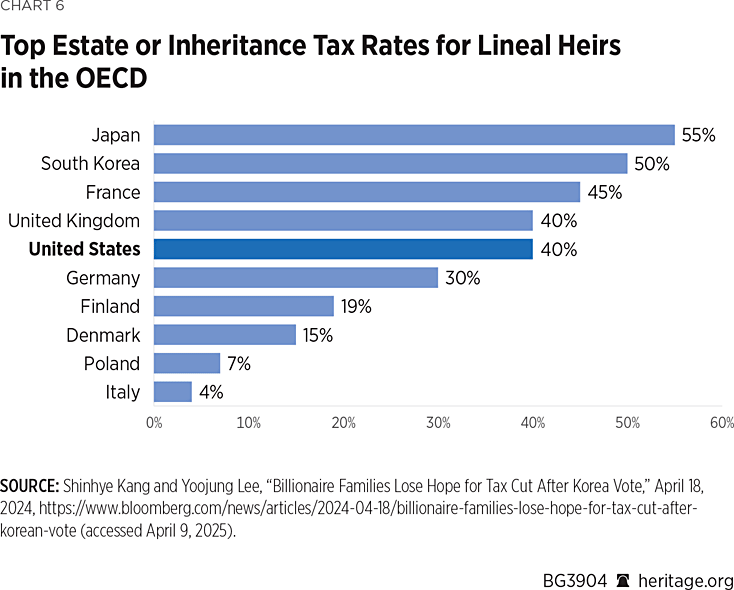
The Trump tax cut ended corporate inversions. One primary goal of the Trump tax cut in 2017 was to stop American companies from fleeing the U.S. and moving headquarters, factories, and jobs overseas. Under Barack Obama, dozens of major companies engaged in tax inversions, which happen when companies move their headquarters to take advantage of lower tax rates outside the U.S.
America had the highest corporate tax rate in the developed world at nearly 40 percent (including state and local taxes) while the rest of the world was at closer to 20 percent and some countries were at or below 15 percent. Cutting the federal corporate tax rate from 35 percent to 21 percent greatly diminished the incentive to pack up and leave the United States.
The policy was an astonishing success. The chart below shows that the number of inversions went to zero after the Trump tax cut. According to former House Ways and Means Committee chairman Kevin Brady, there was not a single inversion from 2018 through 2022.REF The companies stayed here and the jobs stayed here.
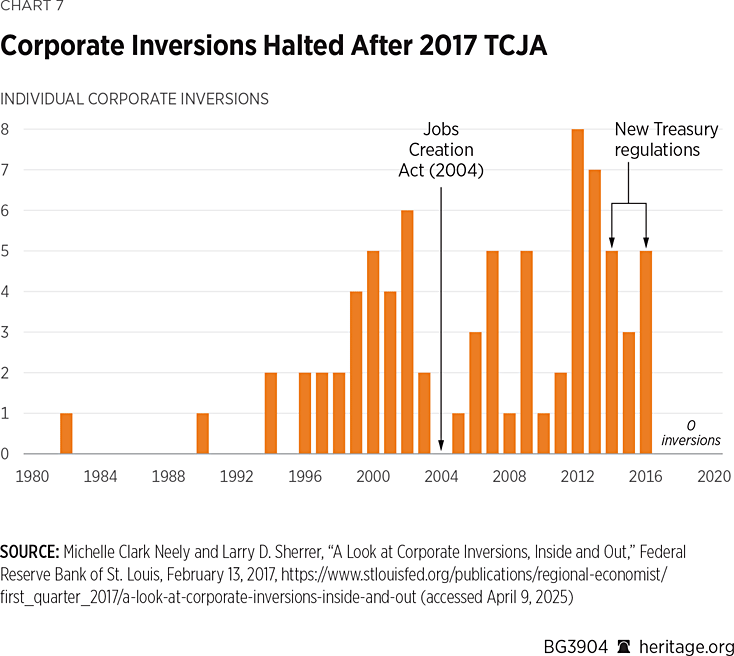
The tax cuts increased investment and growth. One reason the Trump tax cuts raised much more revenue than the budget scorekeepers had predicted is that they used “static analysis” and failed to take into account the positive impact on investment and employment. Much of the growth was a result of three changes in the tax code: the lower corporate tax rate, the lower tax rate on repatriated capital, and the immediate expensing of capital purchases.
Unfortunately, the expensing provisions of the Trump tax cut have already started to phase out and with congressional inaction will be entirely phased out.
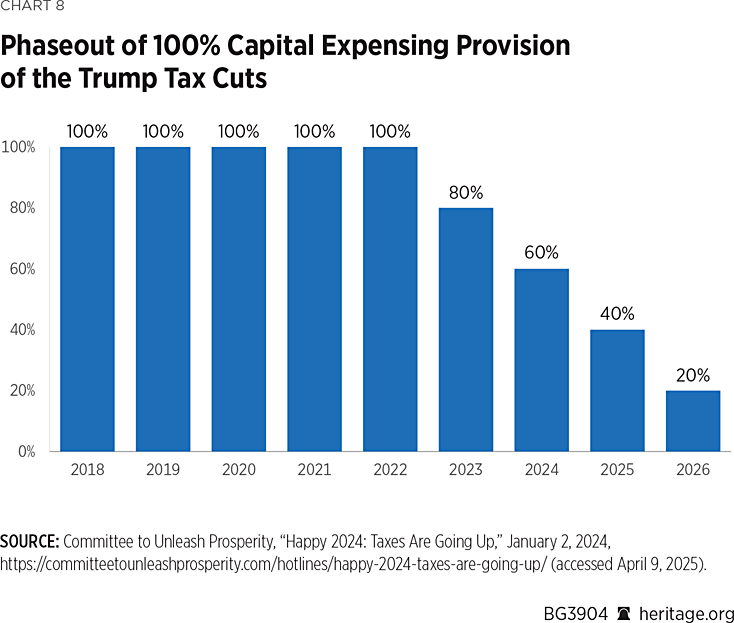
Conclusion
The Trump tax cuts delivered on their promise to help make the U.S. economy stronger and provide more capital investment to help businesses expand and create jobs. Revenues were higher, not lower, than expected. Almost all of the objections that Democrats raised in opposing the Trump tax cuts in 2017 were proven to be fallacious.
If Democrats succeed in repealing that bill, we can expect the following results: Major U.S. companies will start to move their operations, jobs, and headquarters offshore as corporate inversions start up again; the share of taxes paid by the rich is likely to fall because of the reintroduction of loopholes for the rich to shelter their income; middle-class families will see an average increase in their annual income tax burden of roughly $2,000; the tax code will become more complicated and time-consuming because millions more filers will have to itemize their deductions; seven million more families—mostly with middle incomes—will have to pay the alternative minimum tax; the number of non-rich families subject to the death tax will likely double or triple; and tax lawyers and accountants will get very rich.
There is one other point that Democrats refuse to acknowledge: If the entire Trump tax cut is allowed to expire, the result will be one of the largest tax cuts for the super-rich in American history, as it will bring back a giant tax carve-out called the state and local tax deduction for millionaires living in high-tax states.
Stephen Moore is a Visiting Fellow in Economics at The Heritage Foundation and co-author of The Trump Economic Miracle.



